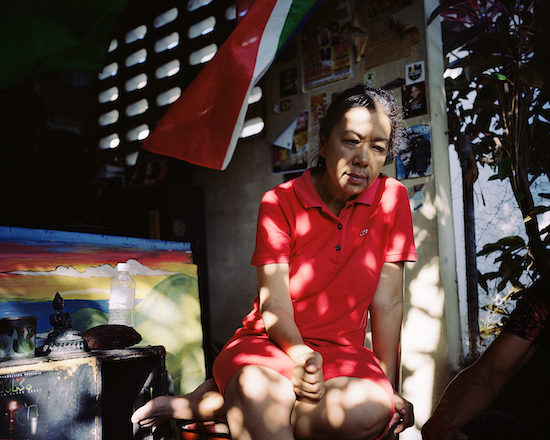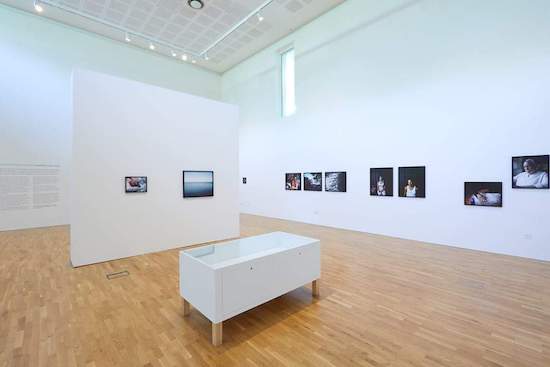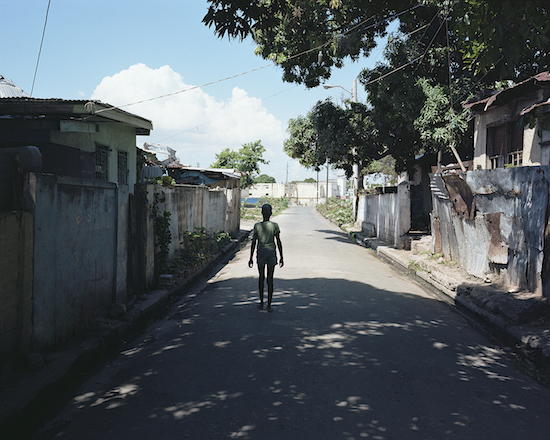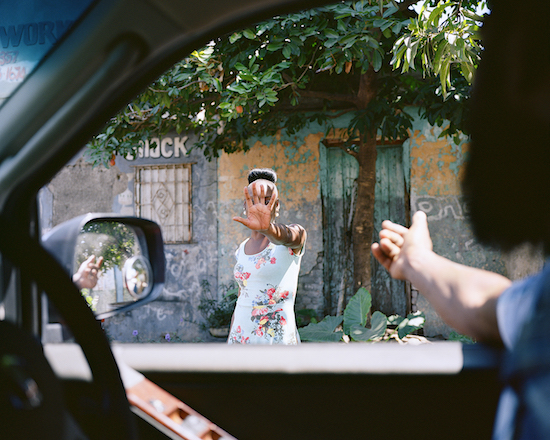Andrew Jackson, Hand, Kingston Jamaica, 2017
Andrew Jackson’s solo exhibition From a Small Island at mac Birmingham is a substantial commission of new work that responds to place, family, memory and the present. Made in both Britain and Jamaica throughout 2017, the exhibition landed after years of planning into the midst of the Windrush crisis. This brought a new context to the personal reflections on family and deconstruction of notions of belonging within the exhibition.
In this exhibition you articulate a first-person familial dialogue on the generation of migrants who came to the United Kingdom who are now framed as the Windrush Generation. What has this opened up for you?
The work exists on multiple layers. Initially, migration is a large theme of the work. There are questions about relationships with parents and, as parents age, those changing roles from being a child to being a care-giver. There are questions about dementia, questions about memory, questions about family and personal histories. I have thought about the sense of belonging and notions of home. It’s been interesting that people have wanted to talk about the experiences of their own parents who are coping with dementia. There seems to be a universality about that experience, about suddenly wanting to be the gatekeeper for somebody’s memories when they are passing on.
There’s a sense of holding onto a dialogue, and that also your parents are holding onto a conversation about a place that they have known. In any form of migratory experience there’s that discussion about return, yet does that happen?
My parents never made that return journey back home. They left in 1956, and for them Jamaica was frozen in that time period. In the ensuing years, they still held onto Jamaica in that 1956 pre-independence concept of the place. Even in terms of the language they spoke, the Patwa they used, their words were still fixed in that time. I found this as I went out to Jamaica and used specific terms which were used in the 1960s. There’s always a difficult problematic for the migrant, who on one hand is using his memories to hold onto who they were, and also at the same time is in the new space where they have now made their real home, in which they are trying to construct a new identity.
For the English, these people are still seen as Jamaican, and that’s also one of the problematics for the second generation who followed. Perhaps more so in the sense that they haven’t got that Jamaican identity to fall back on; they have a perceived or romanticised impression shaped through their parents’ stories. At times, when things are difficult, in that they don’t feel that wanted (and perhaps I’m talking about myself here), you can use this mythical space of Jamaica as a place of solace. It’s the magic space.

Woman in Red Dress, Kingston Jamaica, 2017
In your own journey to Jamaica, you have a sense of coming home to a place you haven’t been to before. That’s a really significant dialogue to share with an audience.
One of the things that I thought would draw me closer to my parents was to have a shared experience of this space. But I found out once I had returned to England and started to talk about Jamaica, it was having a negative effect because it was eroding their memories. Their perceptions of this place obviously did not exist any more. The more that I told them that this road isn’t there anymore or that building is gone and so and so is now there, it was slowly erasing their only connection to Jamaica, which was through their memories. So I found I had to stop talking.
This is the real strength of this exhibition. We look at migratory culture and experiences and put them into these monolithic blocks. Here you are speaking from a first-person narrative that is singular and is yours.
This is the problem with how migration is posited within the media. It’s seen as facts and figures, numbers. Words like ‘swamped’ are being used. It’s not until you break it down to the individual level and look at the human experience of that individual within this process that you are able to create opportunities for the viewer to empathise and imagine how they would feel that experience. I think it’s important to look at the individual. There are these issues when everybody is grouped together, as if every single identity is the same. It’s important to look at the nuances and the intersectionality of migration.

From a Small Island, mac Birmingham, installation shot by David Rowan
Within this exhibition your photographs are composed as groups of images, in which you are looking at specific encounters, and at these particular moments.
I was interested in how the audience negotiates the space, and there was a choice made where you can go left or right. You are given two sets of sequences, and this comes from my mother, in terms of her migratory choice. She could have chosen to go to America or to go to England. The work makes that apparent as there’s one particular image (in a sequence of three) which juxtaposes the street where she was born and lived next to the street in Brooklyn she had had the opportunity to move to. So you have to make an initial choice when you come to the gallery space: do you go this way or that way? And those choices are going to affect your outcomes.
There are also works that punctuate, that are made singular. There are images where you are walking around the structure of the gallery that you then witness. How did those choices take place?
The work stemmed initially from an observation of my parents. In 2010 my dad was seriously ill, and even though I had taken snapshots of my family, more in that experimental way you do when you get a new camera or a new lens, I realised that I did not have a document of my parents. This was before the current Windrush generation crisis in terms of belonging and the government deporting people, which has, in fact, been going on for a long-time.
We just hadn’t discussed it as a nation before… This narrative which you have been working around with this show, that has been planned for years, has just erupted.
I realised that there wouldn’t be any memorials or statues or blue plaques on buildings to say that this generation was here. As they are getting older and their friends are sadly passing on, their legacy is disappearing with them. More than anything, maybe initially for myself, I wanted some record. I wanted a statement which acknowledged that they lived here; they were here.

That generation are pioneers. They did something incredible in coming to this place that was promising them work as part of the commonwealth.
They were coming home. The whole educational process socialised them to see themselves as British subjects. When they came to Britain, they weren’t immigrants – they were British citizens. There’s a strange universality between migrant stories. My mum tells me that when she grew up she collected a scrapbook of news cuttings of princes and princesses and Buckingham Palace, and when she came to England she would see the soldiers in their red tunics walking through Walsall. By a strange twist of fate, I did a commission for the London School of Economics about a young woman who came over from Bratislava. She travelled for twenty-six hours on a coach to become an au pair in Walsall. She couldn’t speak a word of English, but she came here imagining that she’d see those soldiers in the red tunics walking down the high street. There’s still that perception of Britain.
The reality of Britain from the outside and the inside. There’s such a shift there which still continues.
The images people get of Britain from outside the country is still one of period dramas, stately homes and received pronunciation. And it’s mainly white. Migration is never posited as a long term thing. It’s always a short term problem. So this is the reason for looking at what happens when people stay and don’t go home and what happens when they have families and when they age. I wasn’t aware of any works about migrants who age and who stay.
Most parental choices are ones that you are not privy too. They are ones that happen beyond your existence.
We only ever see our parents in a two dimensional way – they’re caregivers. When they are quite young, they are superhuman characters who take care of us. As we get older, we become estranged because we want to create our own identities separately from theirs. We have a new sense of appreciation for their lives. I have no perception of my parents outside of the home, so that’s where, in this body of work, you see them. They are now internalised. They travelled thousands of miles to come to England. In one sense, the decline in their bodies is the decline of the industries they came to work in. I also have no perception of them being Jamaican, which they see themselves as. I always see them in the context of being in England and framed by that. It always feels like my mum is at sea, that the ship that she came in on never really docked in England.
Andrew Jackson’s exhibition From a Small Island is at mac Birmingham until 8 July


